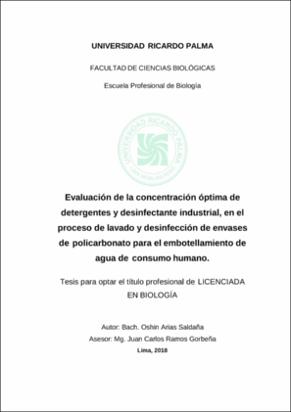| dc.contributor.advisor | Ramos Gorbeña, Juan Carlos | |
| dc.contributor.author | Arias Saldaña, Oshin | |
| dc.date.accessioned | 2018-04-17T19:11:07Z | |
| dc.date.available | 2018-04-17T19:11:07Z | |
| dc.date.issued | 2018 | |
| dc.identifier.uri | https://hdl.handle.net/20.500.14138/1317 | |
| dc.description.abstract | El objetivo de la investigación fue evaluar la concentración optima de los detergentes industriales Multiclean, CF 315 y Poly – Safe y del desinfectante Sterizid Forte 15 en envases de policarbonato durante el proceso de limpieza y desinfección del embotellado de agua de consumo humano. Las concentraciones de los detergentes fueron: 0.1%, 0.25%, 0.50%, 0.75%, 1.0% y el desinfectante a una concentración de 0.2%. Se realizaron dos tipos de tratamientos. El primero solo con el uso de los detergentes y el segundo con los detergentes y desinfectante. El recuento de la carga microbiana inicial y final se realizó mediando el método de enjuague en los envases de policarbonato.
Luego se realizó un recuento de bacterias heterotróficas y coliformes totales por la técnica de recuento en placa (SMEWW Part 9215 B, 22th – 2012). Los datos fueron procesados en el Programa estadístico R. Se demostró que entre los tres detergentes industriales hay una diferencia significativa, P < 0.05, excepto entre el CF 315 y MULTICLEAN, no hay una diferencia significativa, P > 0.05
Además el porcentaje de eficiencia de los detergentes CF 315, MULTICLEAN y POLYSAFE fue de 100%, 99% y 91% con concentración de 1%. Así mismo, el porcentaje de eficiencia del desinfectante Sterizid Forte fue de 100% a una concentración de 0.2% y con un tiempo de contacto de superficie del envase de policarbonato de 2 minutos.
The objective of the research was to evaluate the concentration of the industrial detergents Multiclean, CF 315 and Poly - Safe and Sterizid Forte 15 disinfectant in polycarbonate containers during the process of cleaning and disinfecting the bottling of water for human consumption. The concentrations of the detergents were: 0.1%, 0.25%, 0.50%, 0.75%, 1.0% and the disinfectant at a concentration of 0.2%. Two types of treatments were performed. The first only with the use of detergents and the second with detergents and disinfectant. The count of the initial and final microbial load was carried out by means of the rinsing method in the polycarbonate containers.
Then a count of heterotrophic bacteria and total coliforms was performed by the plate count technique (SMEWW Part 9215 B, 22 of 2012). The data were processed in the R statistical program. It was shown that among the three industrial detergents there is a significant difference, P <0.05, except between CF 315 and MULTICLEAN, there is no significant difference, P > 0.05.
In addition, the efficiency percentage of CF 315, MULTICLEAN and POLYSAFE detergents was 100%, 99% and 91% concentration of 1%. Likewise, the efficiency percentage of the Sterizid Forte disinfectant was 100% at a concentration of 0.2% and with a contact time of the polycarbonate container for 2 minutes. | es_ES |
| dc.description.sponsorship | Submitted by Wong Rafael (rafel_wl@hotmail.com) on 2018-04-17T19:11:07Z
No. of bitstreams: 1
Arias_o.pdf: 4641053 bytes, checksum: b99a5023bef7e69b768be008258e1ca8 (MD5) | es_ES |
| dc.description.sponsorship | Made available in DSpace on 2018-04-17T19:11:07Z (GMT). No. of bitstreams: 1
Arias_o.pdf: 4641053 bytes, checksum: b99a5023bef7e69b768be008258e1ca8 (MD5)
Previous issue date: 2018 | es_ES |
| dc.description.uri | Tesis | es_ES |
| dc.format | application/pdf | |
| dc.language.iso | spa | |
| dc.publisher | Universidad Ricardo Palma - URP | es_ES |
| dc.rights | info:eu-repo/semantics/openAccess | |
| dc.rights.uri | https://creativecommons.org/licenses/by-nc-nd/4.0/ | |
| dc.source | Repositorio Institucional - URP | es_ES |
| dc.subject | Policarbonato | es_ES |
| dc.subject | detergentes | es_ES |
| dc.subject | desinfectante | es_ES |
| dc.subject | bacterias | es_ES |
| dc.subject | eficiencia | es_ES |
| dc.subject | Polycarbonate | es_ES |
| dc.subject | detergents | es_ES |
| dc.subject | disinfectant | es_ES |
| dc.subject | efficiency | es_ES |
| dc.title | “Evaluación de la concentración óptima de detergentes y desinfectante industrial, en el proceso de lavado y desinfección de envases de policarbonato para el embotellamiento de agua de consumo humano.“ | es_ES |
| dc.type | info:eu-repo/semantics/bachelorThesis | |
| thesis.degree.discipline | Biología | es_ES |
| thesis.degree.grantor | Universidad Ricardo Palma. Facultad de Ciencias Biológicas. Escuela Profesional de Biología | es_ES |
| thesis.degree.level | Título Profesional | es_ES |
| thesis.degree.name | Licenciado en Biología | es_ES |
| dc.publisher.country | PE | es_ES |
| dc.subject.ocde | https://purl.org/pe-repo/ocde/ford#1.06.00 | |
| renati.advisor.orcid | https://orcid.org/0000-0002-9713-2653 | |
| renati.type | https://purl.org/pe-repo/renati/type#tesis | |
| renati.level | https://purl.org/pe-repo/renati/nivel#tituloProfesional | |
| renati.discipline | 511206 | |
| renati.juror | Agurto Saenz, Tomas | |
| renati.juror | Ceino Gordillo, Franco Ernest | |
| renati.juror | Foy Valencia, Enzio Carol | |
| dc.type.version | info:eu-repo/semantics/publishedVersion | |
| renati.author.dni | 47409458 | |
| renati.advisor.dni | 10243429 | |


